TEST BANK NCLEX QUESTIONS AND ANSWERS ALL UPDATED
Document Content and Description Below
ST BANK NCLEX QUESTIONS AND ANSWERS ALL UPDATED WELL 2021 QUESTIONS 1-15 Ref # 4366 The nurse receives a client from the post anesthesia care unit following a left femoral-popliteal bypass gr aft proc... edure. Which of the following assessments requires immediate notification of the health care provider? • Left foot is cool to the touch • Absent left pedal pulse using Doppler analysis • Inability to palpate the left pedal pulse • Acute pain in the left lower leg Although the inability to palpate the left pedal pulse, a cool extremity, and increased pain in the left lower leg are important findings, they all require additional nursing assessment prior to contacting the health care provider. In clients without palpable pedal pulses, the next step in the assessment is to perform a Doppler analysis. The inability to locate the left pedal pulse using the Doppler analysis requires immediately notifying the health care provider. Ref # 1028 There's a new medication order that reads: "administer 1 gtt ciprofloxacin solution OD Q 4 h" What action should the nurse take? Call the prescriber to clarify and rewrite the order Abbreviations, symbols and dose designations can be misinterpreted and lead to medication errors. "OD" can mean "right eye" (oculus dexter) or "once daily"; it should never be used when communicating medical information. The abbreviation "Q" should be written out as "every." Although "gtt" is not on the official "Do Not Use List", it's best to use "drop" instead. Asking other nurses to interpret an order is a potentially dangerous "workaround." The nurse should call the health care provider who prescribed the medication and clarify the order. Ref # 1440 Which individual is at greatest risk for the development of hypertension? 45 year-old African-American attorney The incidence of hypertension is greater among African-Americans than other groups in the United States. The incidence among the Hispanic population is rising. Ref # 2446 A woman, who delivered five days ago and who had been diagnosed with pregnancy induced hypertension (PIH), calls a hospital triage nurse hotline to ask for advice. She states, "I have had the worst headache for the past two days. It pounds and by the middle of the afternoon everything I look at looks wavy. Nothing I have taken helps." What should the nurse do next? Ask the client to stay on the line, get the address, and send an ambulance to the home The woman is at risk for seizure activity. The ambulance needs to bring the woman to the hospital for evaluation and treatment. For at-risk clients, PIH may progress to preeclampsia and eclampsia prior to, during, or after delivery; this may occur up to 10 days after delivery. Ref # 2065 A client expresses anger when a call light is not answered within five minutes. The client demanded a blanket. How should the nurse respond? "I see this is frustrating for you. I have a few minutes so let's talk." This is the best response because it gives credence to the client's feelings and then concerns. To say "let's talk" and ask a why question is not a therapeutic approach because it does not acknowledge or validate the client's feelings. To apologize and not notice the client's feelings is inappropriate. To say it could have waited a few minutes is rude and non-accepting of the client's verbalized needs. Ref # 2134 The client is admitted to an ambulatory surgery center and undergoes a right inguinal orchiectomy. Which option is the priority before the client can be discharged to home Post-operative pain is managed An orchiectomy is the surgical removal of one or both testicles. It is usually performed to treat cancer (testicular, prostate or cancer of the male breast), but it may also be performed to prevent cancer (with an undescended testicle.) Due to the location of the incision, pain management is the priority. Most men will be able to eat regularly when they get home; they should at least tolerate liquids before discharge. It's important that the client is able to get up and walk with assistance, but this is not the priority. Psychological counseling may be needed as part of long-term aftercare, but this is not an immediate priority. Ref # 1524 A nurse is teaching a group of adults about modifiable cardiac risk factors. Which of the following should the nurse focus on first? Smoking cessation Smoking cessation is the priority for clients at risk for cardiac disease. Smoking's effects result in reduction of cell oxygenation and constriction of the blood vessels. All of the other factors should be addressed at some point in time. Ref # 1721 The clinic nurse is assisting with medical billing. The nurse uses the DRG (Diagnosis Related Group) manual for which purpose? Determine reimbursement for a medical diagnosis DRGs are the basis of prospective payment plans for reimbursement for Medicare clients. Other insurance companies often use it as a standard for determining payment. KEYWORDS DRG diagnosis related group reimbursement Ref # 1328 A nurse is planning care for a 2 year-old hospitalized child. Which issue will produce the most stress at this age? Separation anxiety While a toddler will experience all of the stresses, separation from parents is the major stressor. Separation anxiety peaks in the toddler years. Ref # 2319 The nurse is reviewing the laboratory results for several clients. Which of the laboratory result indicates a client with partly compensated metabolic acidosis? PaCO2 30 mm Hg Metabolic acidosis can be caused by many conditions, including renal failure, shock, severe diarrhea, dehydration, diabetic acidosis, and salicylate poisoning. With metabolic acidosis, you should expect a low pH (less than 7.35) and a low HCO3 (less than 22 mEq/L.) Compensation means the body is trying to get the pH back in balance; therefore, a pure metabolic acidosis should elicit a compensatory decrease in PaCO3 (normal is 35-45 mm Hg.) The hemoglobin is within normal limits (WNL) for both males and females. The chloride and sodium results are also WNL. Ref # 2391 A client with a diagnosis of methicillin-resistant Staphylococcus aureus (MRSA) has died. Which type of precautions is appropriate to use when performing postmortem care? Contact precautionsThe resistant bacteria remain alive for up to three days after the client dies. Therefore, contact precautions must still be used. The body should also be labeled as MRSA-contaminated so that the funeral home staff can protect themselves as well. Gown and gloves are required. Ref # 1436 A client has a chest tube inserted immediately after surgery for a left lower lobectomy. During the repositioning of the client during the first postop check, the nurse notices 75 mL of a dark, red fluid flowing into the collection chamber of the chest drain system. What is the appropriate nursing action? Continue to monitor the rate of drainage It is not unusual for blood to collect in the chest and be released into the chest drain when the client changes position this soon after surgery. The dark color of the blood indicates it is not active bleeding inside of the chest. Sanguinous drainage should be expected within the initial 24 hours postop, progressing to serosanguinous and then to a serous type. If the drainage exceeds 100 mL/hr, the nurse should call the surgeon. Ref # 1623 A client is transported to the emergency department after a motor vehicle accident. When assessing the client 30 minutes after admission, the nurse notes several physical changes. Which finding would require the nurse's immediate attention? Tracheal deviation Tracheal deviation is a sign that a mediastinal shift has occurred, most likely due to a tension pneumothorax. Air escaping from the injured lung into the pleural cavity causes pressure to build, collapsing the lung and shifting the mediastinum to the opposite side. This obstructs venous return to the heart, leading to circulatory instability and may result in cardiac arrest. This is a medical emergency, requiring emergency placement of a chest tube to remove air from the pleural cavity relieving the pressure. Ref # 1319 The client is diagnosed with cystic fibrosis (CF). The nurse would expect the client to be treated with oral pancreatic enzymes and which type of diet? High fat, high-calorie CF affects the cells that produce mucus, sweat and digestive juices. Someone with CF needs a high-energy diet that includes high-fat and high-calorie foods, extra fiber to prevent intestinal blockage and extra salt (especially during hot weather.) People with CF are at risk for osteoporosis and need calcium and dairy products. Someone with celiac disease or with a gluten intolerance, not CF, needs a gluten-free diet. Ref # 1646 The nurse is assessing a 4 year-old child who is in skeletal traction 24 hours after surgical repair of a fractured femur. The child is crying and reports having severe pain. The right foot is pale and there is no palpable pulse. What action should the nurse take first? Notify the health care provider Pain and absence of a pulse within 48-72 hours after a severe injury to an extremity suggests acute compartment syndrome. This condition occurs when there's a build up of pressure within the muscles; this pressure decreases blood flow and can cause muscle and nerve damage. Acute compartment syndrome is a medical emergency. Surgery is needed immediately; delaying surgery can lead to permanent damage to the extremity. Ref # 1927 The nurse is examining a 2 year-old child with a tentative diagnosis of Wilm's tumor. The nurse would be most concerned about which statement by the mother? "Urinary output seems to be less over the past two days." Wilm's tumor is a malignant tumor of the kidney that can lead to kidney dysfunction; therefore, a recent decrease in urinary output should be investigated further as it may be a sign of renal dysfunction. Increasing abdominal girth is a common finding in Wilm's tumor, but does not require immediate intervention by the nurse. Ref # 1370 A child is treated with succimer for lead poisoning. Which of these assessments should the nurse perform first? Check complete blood count (CBC) with differential Succimer (Chemet) is used in the management of lead or other heavy metal poisoning. Although it has generally well tolerated and has a relatively low toxicity, it may cause neutropenia. Therapy should be withheld or discontinued if the absolute neutrophil count (ANC) is below 1200/µ Ref # 1773The client with a T-2 spinal cord injury reports having a "pounding" headache. Further assessment by the nurse reveals excessive sweating, rash, pilomotor erection, facial flushing, congested nasal passages and a heart rate of 50. What action should the nurse take next? Check the client for bladder distention and the urinary catheter for kinks These are findings of autonomic dysreflexia, also called hyperreflexia. This response occurs in clients with a spinal cord injury above the T-6 level. It is typically initiated by any noxious stimulus below the level of injury such as a full bladder, an enema or bowel movement, fecal impaction, uterine contractions, changing of the catheter and vaginal or rectal examinations. The stimulus creates an exaggerated response of the sympathetic nervous system and can be a life-threatening event. The BP is typically extremely high. The priority action of the nurse is to identify and relieve the cause of the stimulus. Ref # 2144 A 67 year-old client is admitted with substernal chest pressure that radiates to the jaw. The admitting diagnosis is acute myocardial infarction (MI). What should be the priority nursing diagnosis for this client during the first 24 hours? Altered tissue perfusion In the immediate post MI period, altered tissue perfusion is priority, as an area of myocardial tissue has been damaged by a lack of blood flow and oxygenation. Interventions should be directed toward promoting tissue perfusion and oxygenation. The other problems are also relevant, but tissue perfusion is the priority. Ref # 1740An external disaster has occurred in the town. The triage nurse from the emergency department is transported to the site and assigned to triage the injured. Which of these clients would the nurse tag as "to be seen last" by the providers at the scene? A middle-aged person with deep abrasions that are over 90% of the body The clients that are least likely to survive are to be tagged as the "last to be seen." Deep abrasions are usually treated as second or third degree burns because the fluid loss is great. ref # 1750The nurse is caring for a client who is in the advanced stage of multiple myeloma. Which action should be included in the plan of care? Careful repositioning Multiple myeloma occurs when abnormal plasma cells (myeloma cells) collect in several bones. This disease may also harm other tissues and organs, especially the kidneys. This type of cancer causes hypercalcemia, renal failure, anemia,and bone damage. Because multiple myeloma can cause erosion of bone mass and fractures, extra care should be taken when moving or positioning a client due to the risk of pathological fractures. Ref # 2332 The nurse is teaching the client with chronic renal failure (CRF) about medications. The client questions the purpose of taking aluminum hydroxide. What is the best explanation for the nurse to give the client about the therapeutic effects of this medication? It decreases serum phosphate Aluminum binds phosphates that tend to accumulate in the client with chronic renal failure due to decreased filtration capacity of the kidney. Antacids such as Amphojel are commonly used to decrease serum phosphate. Ref # 1771The nurse is caring for a client in the late stages of amyotrophic lateral sclerosis (ALS). Which finding would the nurse expect? (Stephen hawkins) Shallow respirations ALS is a chronic progressive neurodegenerative disease that affects nerve cells in the brain and spinal cord. In ALS, upper and lower motor neurons degenerate (die) and stop sending messages to muscles; all muscles under voluntary control eventually weaken and atrophy. People eventually lose their ability to speak, eat, move and breathe. However, ALS does not impair a person's mind or intelligence. ALS does not affect a person's ability to see, smell, taste, hear or recognize touch. Ref # 1625 A nurse is caring for a client two hours after a right lower lobectomy. During the assessment of the chest drainage unit (CDU), the nurse notes bubbling in the water-seal chamber. What is the first action the nurse should take? Assess the chest tube dressing, tubing and drainage system The first action the nurse should take is to thoroughly check the dressing, tubing and drainage system. Usually intermittent bubbling in the water-seal chamber right after surgery indicates an air leak from the pleural space; this is a common finding and should resolve as the lung re-expands. Continuous bubbling usually means a leak in the CDU, such as a loose connection or a leak around the insertion site. Other nursing actions will include assessing the color and amount of the drainage and assessing the lungs. After the initial post-operative period, the nurse will assist the client to change positions and cough and deep breath to help re-expand the lung and promote fluid drainage. Ref # 1551Today's prothrombin time for a client receiving warfarin 20 seconds. The normal range listed by the lab is 10 to 14 seconds. What is an appropriate nursing action? Recognize that this is a therapeutic level For the client on warfarin therapy, this prothrombin level is within the therapeutic range. Therapeutic levels for warfarin are usually 1 1/2 to 2 times the normal levels. Ref # 1599 The nurse is teaching a client with coronary artery disease about nutrition. What information should the nurse be sure to emphasize Avoid large and heavy meals Eating large, heavy meals can pull blood away from the heart for the digestion process. This may result in angina for clients with coronary artery disease. Sodium for clients with cardiac disease is limited to two grams per day. Three meals a day is a correct approach. However, it does not mention the size of the meal, which is more important. Ref # 1749 The client, who is receiving chemotherapy through a central venous access device (CVAD) at home, is admitted to the intensive care unity (ICU) with a diagnosis of sepsis. Which of the following nursing interventions is the priority? Prepare the client for insertion of a new CVAD Many cases of sepsis occur in immunocompromised clients and clients with chronic and debilitating diseases. Since it's likely the existing CVAD is the source of the infection, it should be cultured and removed. A new central line (usually an internal jugular or subclavian) needs to be inserted since large amounts of IV fluids are needed to restore perfusion. The new central line will also allow venous access for labs, medications and measuring central venous pressure. Together with central venous pressure monitoring, an indwelling urinary catheter will help guide fluid volume replacement. Many hospitals have restrictions on visitors with known or recent infections to help protect all clients. Ref # 1525 The client is scheduled for coronary artery bypass. Based on principles of teaching and learning, what is the best initial approach by the nurse during pre-op teaching? Assess the client's learning style As with any anticipatory teaching, assessment of the client's level of knowledge and learning style should occur first. If possible, the three senses of hearing, seeing and touching should be used during any teaching to enhance recall Ref # 1246 During assessment of orthostatic vital signs on a client with cardiomyopathy, the nurse finds that the systolic blood pressure (BP) decreased from 145 to 110 mm Hg between the supine and upright positions while the heart rate (HR) rose from 72 to 96 beats per minute. In addition, the client reports feeling lightheaded when standing up. The nurse should implement which of the following actions? Instruct client to increase fluid intake for several hours This client is experiencing postural hypotension, a decrease in systolic blood pressure 15 mm Hg accompanied by an increase in heart rate 15 to 20 beats above the baseline with a change in position from supine to upright. This is often accompanied by lightheadedness. Fluid replacement is appropriate, but must be instituted very cautiously, as this client with cardiomyopathy will also be very sensitive to changes in fluid status and fluid overload may develop rapidly with aggressive rehydration. After the client increases fluid intake for one to two hours, the client should be reassessed for resolution of the postural hypotension. Ref # 1595 The nurse is caring for a client diagnosed with acute angina. [Show More]
Last updated: 3 weeks ago
Preview 1 out of 35 pages

Reviews( 0 )
Recommended For You
*NURSING> NCLEX-RN > Neuro Nclex Questions and Answers. Revision best. All Listed below (All)
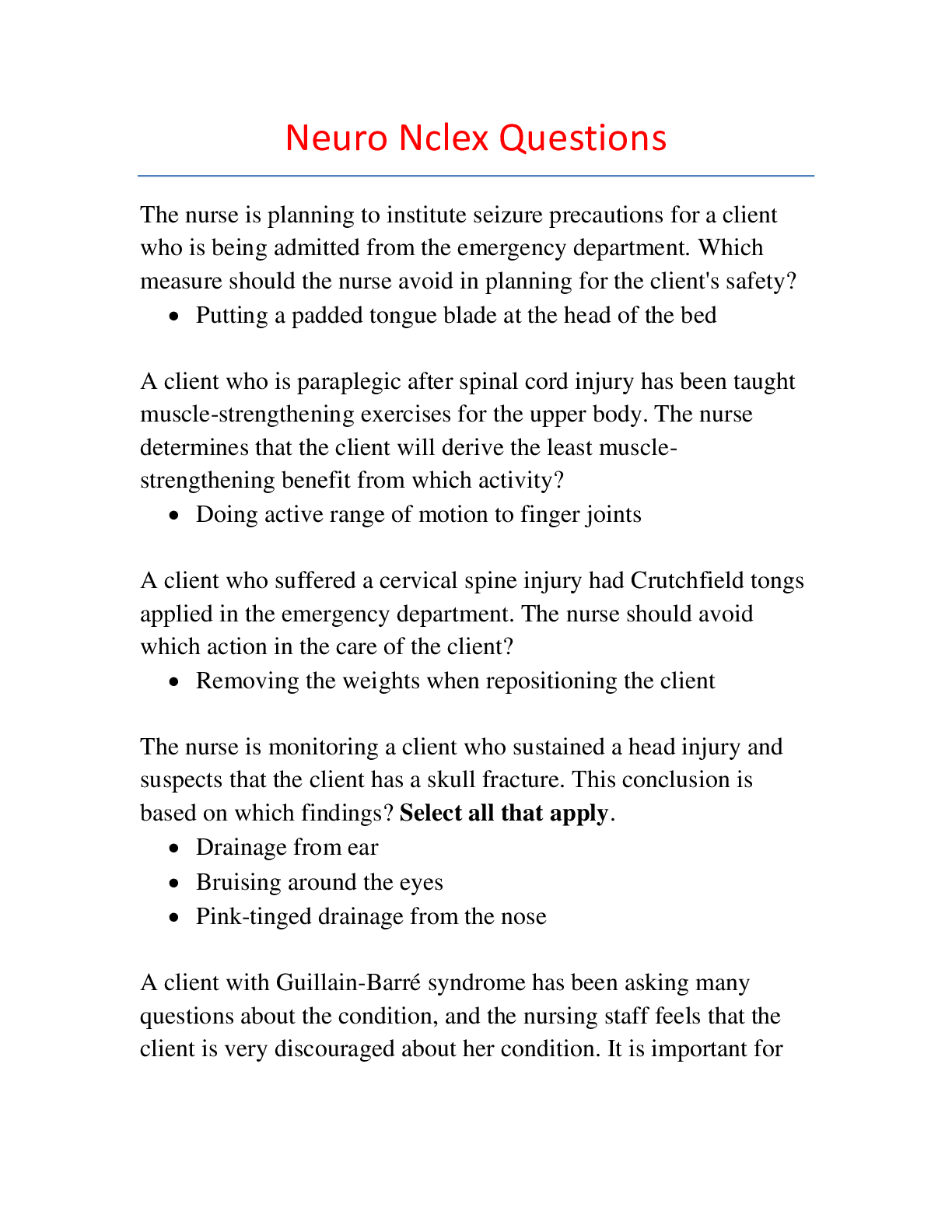
Neuro Nclex Questions and Answers. Revision best. All Listed below
Neuro Nclex Questions The nurse is planning to institute seizure precautions for a client who is being admitted from the emergency department. Which measure should the nurse avoid in planning for the...
By QuizMaster , Uploaded: Aug 20, 2020
$5.5
*NURSING> NCLEX-RN > TEST BANK NCLEX QUESTIONS AND ANSWERS ALL UPDATED WELL 2021 QUESTIONS 1 TO 15 (All)
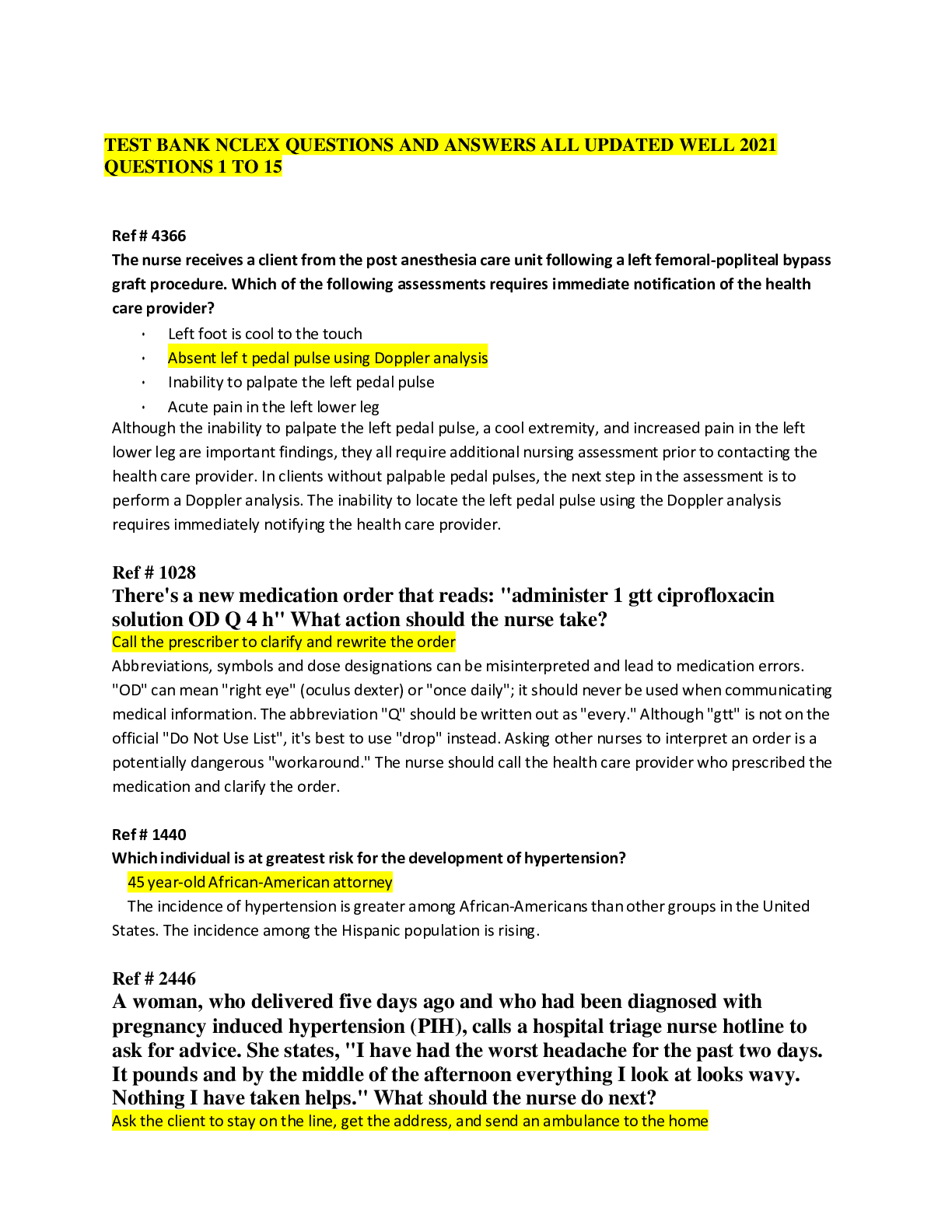
TEST BANK NCLEX QUESTIONS AND ANSWERS ALL UPDATED WELL 2021 QUESTIONS 1 TO 15
The nurse receives a client from the post anesthesia care unit following a left femoral-popliteal bypass graft procedure. Which of the following assessments requires immediate notification of the heal...
By destinyd , Uploaded: Jun 29, 2021
$10.5
*NURSING> NCLEX-RN > TEST BANK NCLEX questions and answers with complete solutions (All)

TEST BANK NCLEX questions and answers with complete solutions
TEST BANK NCLEX questions and answers with complete solutions
By klaus , Uploaded: May 04, 2021
$15
*NURSING> NCLEX-RN > RN NCLEX QUESTIONS AND ANSWERS 2022 LATEST UPDATE (All)
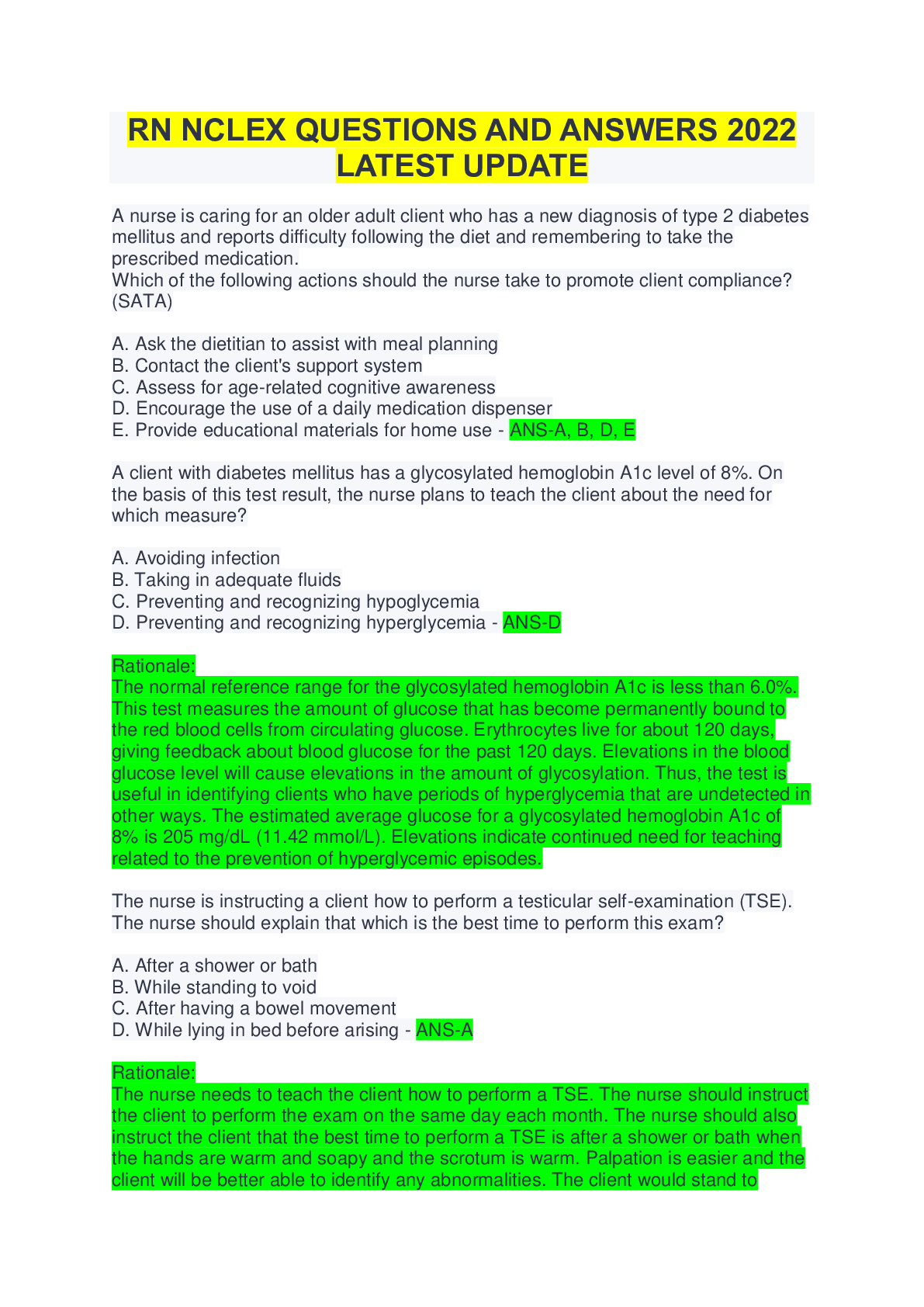
RN NCLEX QUESTIONS AND ANSWERS 2022 LATEST UPDATE
RN NCLEX QUESTIONS AND ANSWERS 2022 LATEST UPDATE A nurse is caring for an older adult client who has a new diagnosis of type 2 diabetes mellitus and reports difficulty following the diet and reme...
By BRAINEDGE , Uploaded: Oct 07, 2022
$7
*NURSING> NCLEX-RN > RN NCLEX QUESTIONS AND ANSWERS 2022 (All)
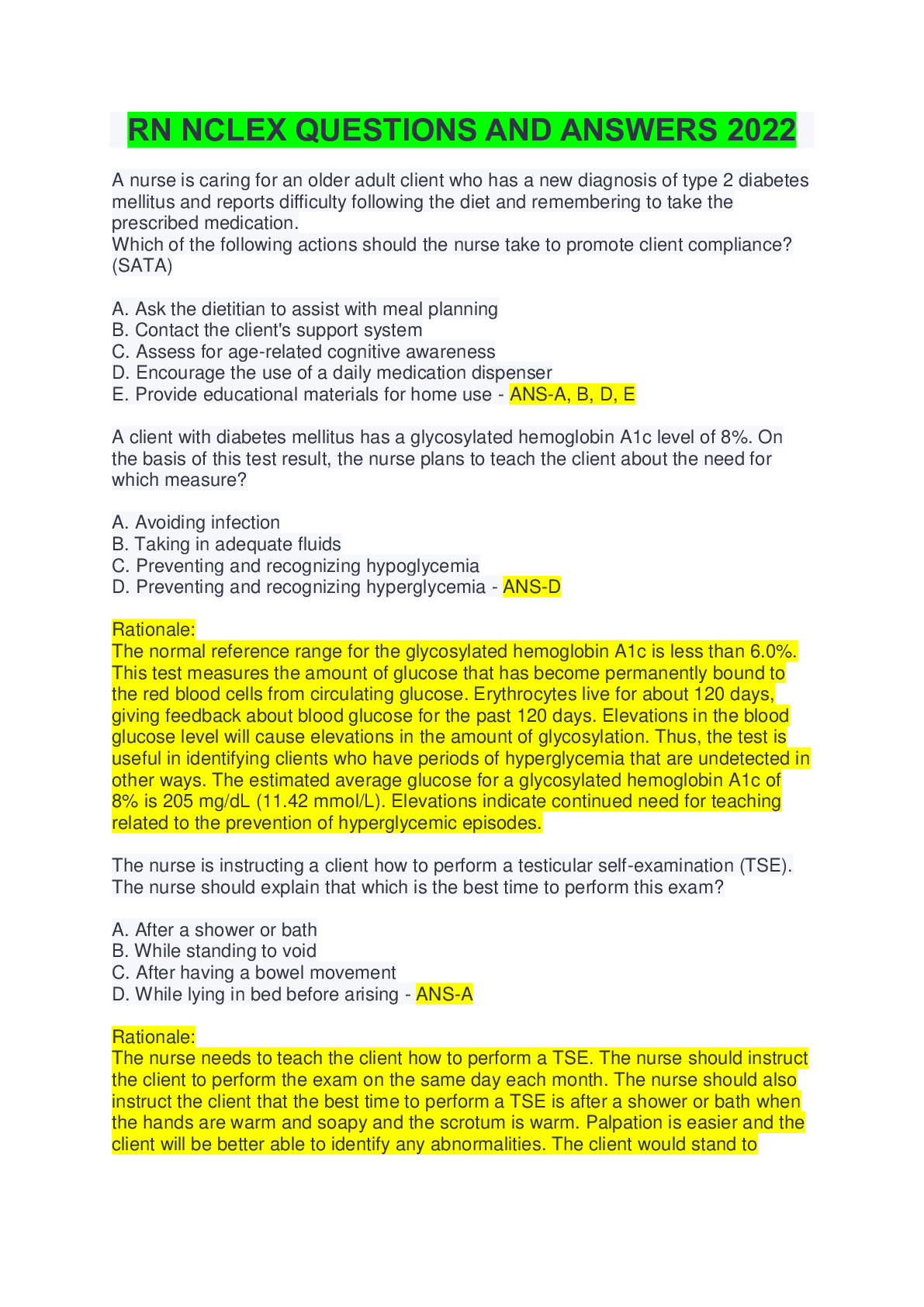
RN NCLEX QUESTIONS AND ANSWERS 2022
RN NCLEX QUESTIONS AND ANSWERS 2022 A nurse is caring for an older adult client who has a new diagnosis of type 2 diabetes mellitus and reports difficulty following the diet and remembering to take...
By BRAINEDGE , Uploaded: Oct 07, 2022
$7.5
*NURSING> NCLEX-RN > LITHIUM RN NCLEX QUESTIONS AND ANSWERS 2022 (All)
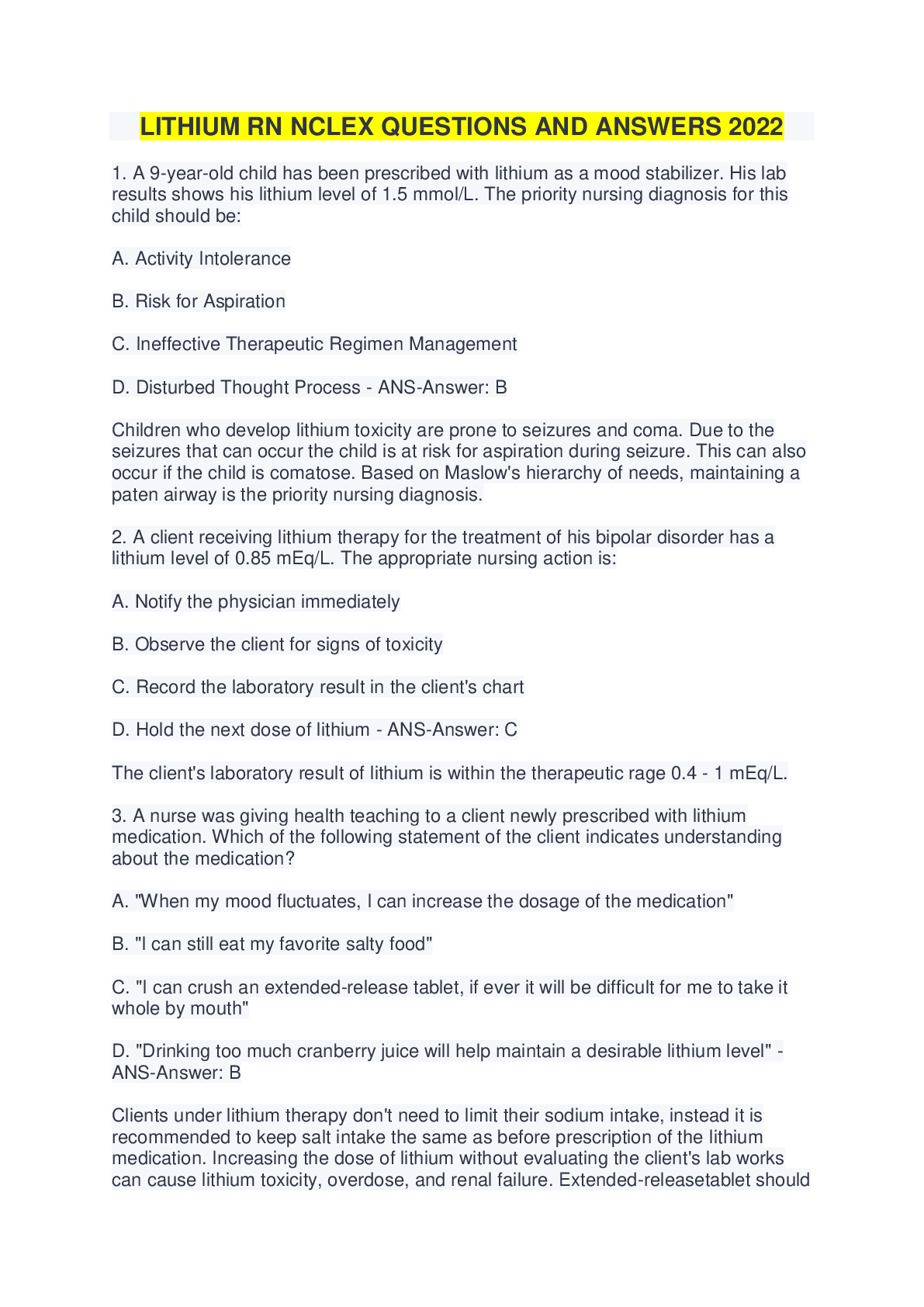
LITHIUM RN NCLEX QUESTIONS AND ANSWERS 2022
LITHIUM RN NCLEX QUESTIONS AND ANSWERS 2022 1. A 9-year-old child has been prescribed with lithium as a mood stabilizer. His lab results shows his lithium level of 1.5 mmol/L. The priority nursing...
By BRAINEDGE , Uploaded: Oct 07, 2022
$10.5
*NURSING> NCLEX-RN > RN- NCLEX QUESTIONS AND ANSWERS IMMUNITY 2022 (All)
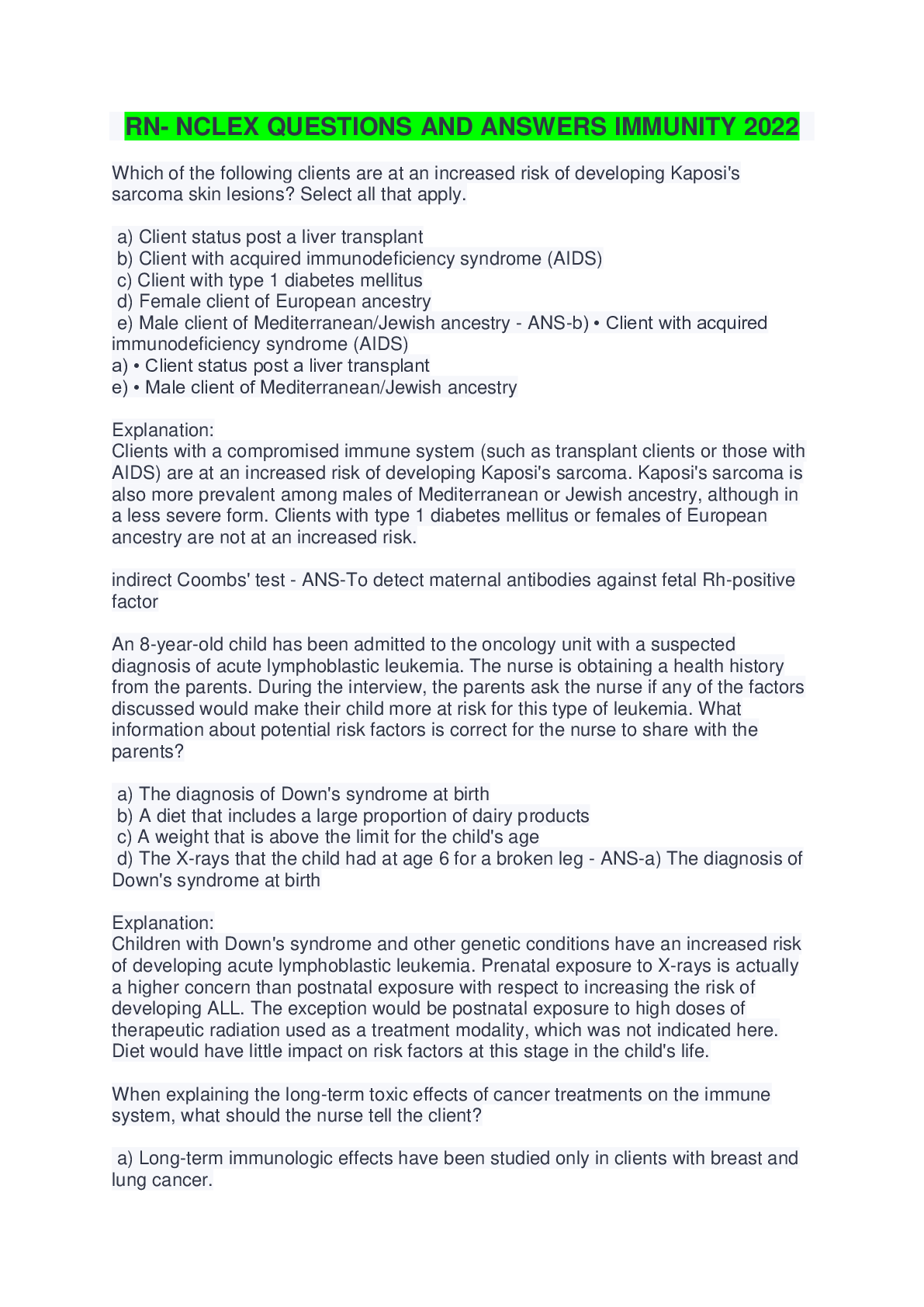
RN- NCLEX QUESTIONS AND ANSWERS IMMUNITY 2022
RN- NCLEX QUESTIONS AND ANSWERS IMMUNITY 2022 Which of the following clients are at an increased risk of developing Kaposi's sarcoma skin lesions? Select all that apply. a) Client status post a li...
By BRAINEDGE , Uploaded: Oct 07, 2022
$10
*NURSING> NCLEX-RN > RN- NCLEX QUESTIONS AND ANSWERS IMMUNITY 2022 (All)

RN- NCLEX QUESTIONS AND ANSWERS IMMUNITY 2022
RN- NCLEX QUESTIONS AND ANSWERS IMMUNITY 2022 Which of the following clients are at an increased risk of developing Kaposi's sarcoma skin lesions? Select all that apply. a) Client status post a li...
By BRAINEDGE , Uploaded: Oct 07, 2022
$10
*NURSING> NCLEX-RN > Actual tests NCLEX-RN Compilation. (All)
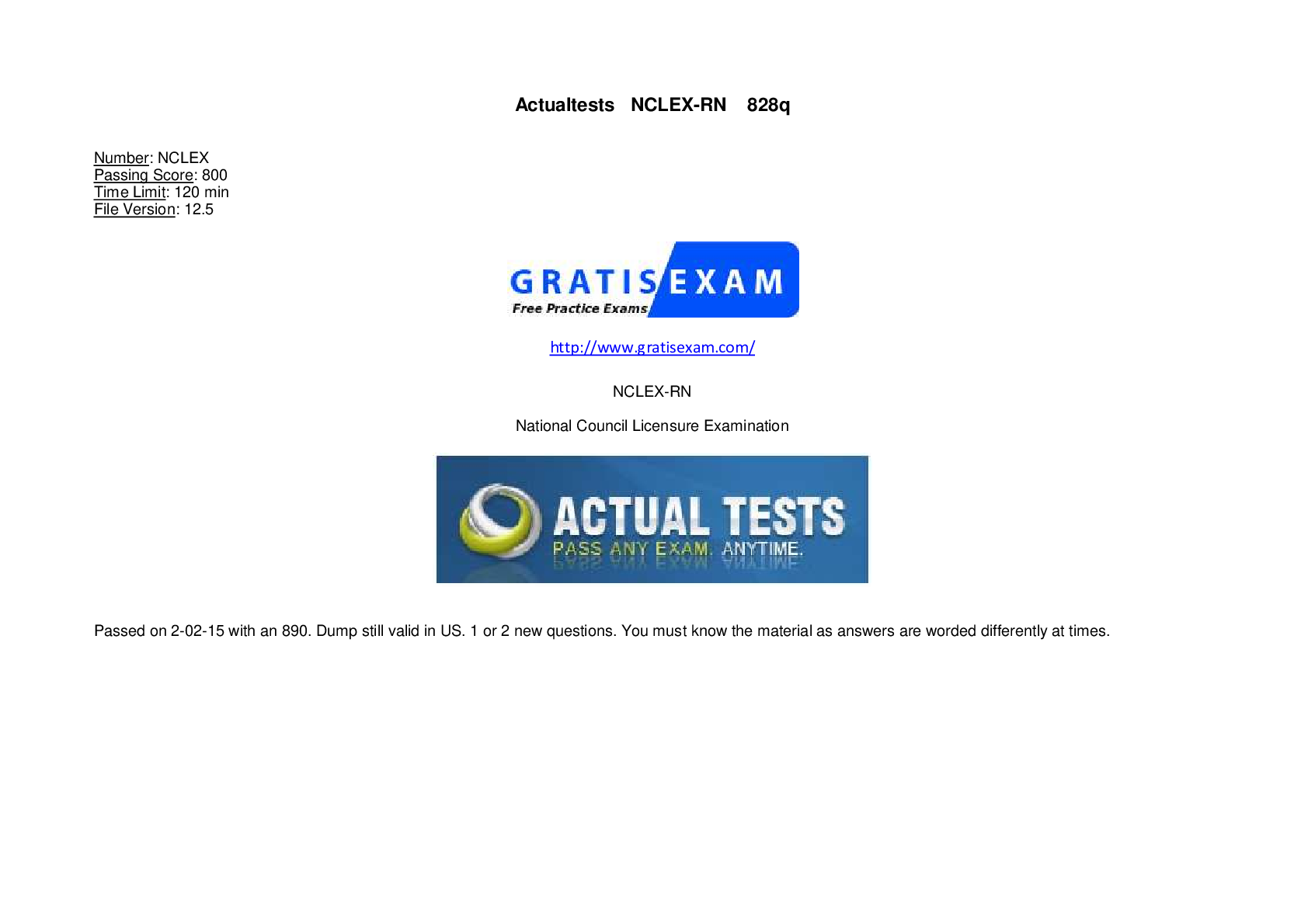
Actual tests NCLEX-RN Compilation.
NCLEX-RN QUESTION 1 A 25-year-old client believes she may be pregnant with her first child. She schedules an obstetric examination with the nurse practitioner to determine the status of her possibl...
By Cheryshev , Uploaded: Sep 12, 2021
$30
*NURSING> NCLEX-RN > NCLEX RN Cardiovascular 150 Q&A. The most commonly tested exam questions. (All)
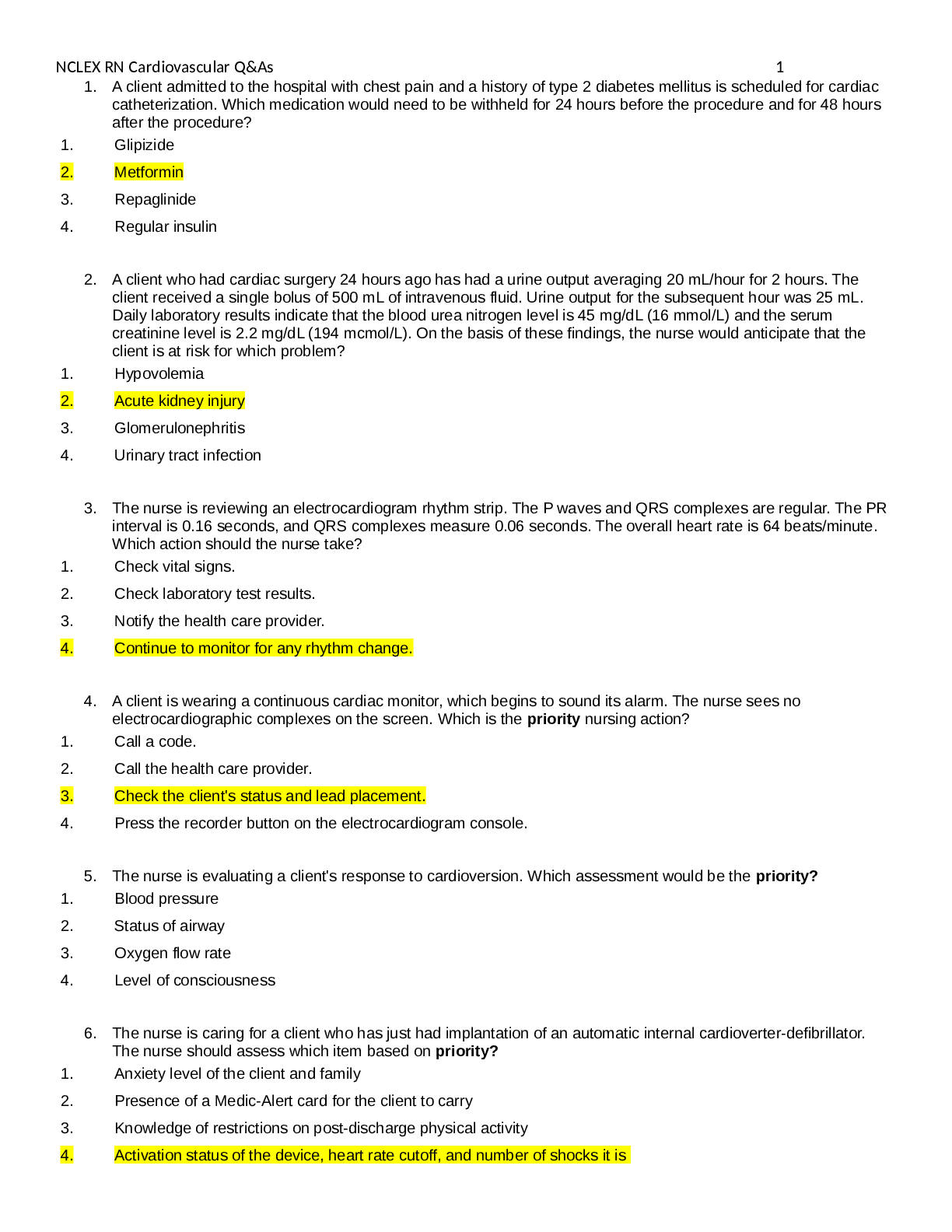
NCLEX RN Cardiovascular 150 Q&A. The most commonly tested exam questions.
NCLEX RN Cardiovascular 150 Q&As 1. A client admitted to the hospital with chest pain and a history of type 2 diabetes mellitus is scheduled for cardiac catheterization. Which medication would ne...
By QuizMaster , Uploaded: Aug 20, 2020
$10
Document information
Connected school, study & course
About the document
Uploaded On
Mar 14, 2021
Number of pages
35
Written in
Additional information
This document has been written for:
Uploaded
Mar 14, 2021
Downloads
3
Views
433






